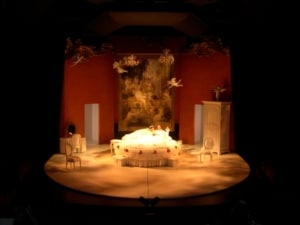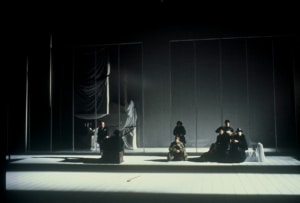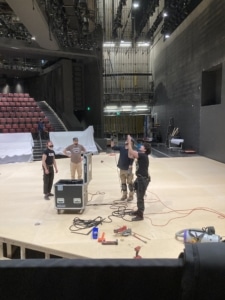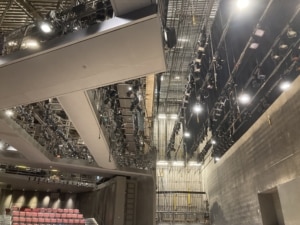DCPA NEWS CENTER
Enjoy the best stories and perspectives from the theatre world today.
Enjoy the best stories and perspectives from the theatre world today.
The DCPA Theatre Company’s production of The Color Purple is a homecoming of sorts for Lighting Designer Peter Maradudin.
“The last production I lit at DCPA was in 2004 (too long ago, if you ask me…),” said Maradudin. “It was The Misanthrope, directed by Nagle Jackson.

Ruth Eglsaer and Jamie Horton in The Misanthrope. Denver Center Theatre Company ’04-’05
“Prior to that, I lit numerous productions in the late 80s/early 90s, when [Artistic Director] Donovan Marley and [Producing Director] Barbara Sellars were in charge, including Garland Wright’s The Cherry Orchard, Guys and Dolls, Peter Pan, Company, A Little Night Music, Carousel…a lot of musicals.”
In the nearly 20 years since he last worked with the Theatre Company, lighting design has changed in an extraordinary way, which local audiences can appreciate in the newly remodeled Wolf, Kilstrom and Singleton theatres.
“We are now in the world of digital lighting, as opposed to analog/incandescent lighting,” Maradudin explained. “To change the coloration of a scene used to require multiple lighting instruments, each with its own color. Now, many lights have LED sources, which can be programmed to be any color one wants. The lighting control consoles have become more sophisticated as well, to make this manipulation, and that of moving lights, more intuitive for a designer. The result is fewer lights, using less energy, doing more — at the flick of a switch.”

The cast of The Cherry Orchard. Denver Center Theatre Company ’85-’86
While he makes it sound simple, each production requires hundreds of hours from a dedicated team. In this case, he’s working with the same team that created previous productions of The Color Purple for Portland Center Stage and Signature Theatre Company in Virginia.
According to Charles Macleod, the DCPA Theatre Company’s veteran Lighting Director, The Color Purple will use 328 lighting fixtures, 20% of which are LED powered. Additionally, there are 250 light cues, five automated fixtures and two “follow” spots, which collectively have 62 cues.
“Tony Cisek’s set design allows me so many opportunities,” he said. “For such a simple looking environment, it has the capacity to shift us from outside to inside, from Mister’s farm to the African coast, from a Church on Sunday to a prison cell. A very inspiring environment in which to tell a story, enhanced by light.”
But the overarching goal is simplicity. “It is such a personal, and often painful, story that I took Timothy Douglas’ direction to heart: this is a play with music, not a musical. By that we meant that we’re eschewing many of the lighting tropes of musicals, such as lots of color, lots of lighting movement, etc. I really enjoy taking a back seat to great acting and singing, supported by a truly beautiful set and perfectly designed clothing for the characters.”

Lighting technicians during the load-in process for The Color Purple
Despite its simplicity, there are certain techniques that Maradudin draws upon to complement the story as it unfolds such as “…shifts in the tonality of the lighting that should impact the audience and enhance the story. If you’re paying attention, there is very little use of color during the first part of the show. But once we see Africa in Celie’s head, as told by her sister, Nettie, color enters the equation. From that point on, color is used more and more, given that moments like Africa, or the visions in Mister’s head during his nightmare, are as much psychological as anything.”
While lighting is certainly not intended to be in the spotlight (pun intended), no play can exist without it. Consider seeing a play with only the houselights on. Would you understand the appropriate tone, instantly know when a scene is shifting or even understand where you are intended to focus your attention?
Consider Celie. She “is lit throughout the show. It’s her story, her reminiscence, and we therefore never lose track of her. And when she realizes her self-love, you may feel that every light in the theatre is focused on her, amplifying the power of her discovery,” Maradudin explained.

The Wolf Theatre
“Watch carefully how some of the musical numbers are constructed lighting-wise,” he continued. “Often we start in a location-specific look; then, as the music builds, or changes key or shifts into a chorus, the lighting will evolve along with it: building, shifting, etc., until a final build of light with music to a sharp punctuation — both musically and lighting movement-wise (a “bump,” we call it). The combination of the two can bring an audience to its feet in a way that one or the other on its own might not.”
It almost sounds like the crescendo of a musical score and, in many ways, it is, for without one, would you fully enjoy the other? Certainly in Shakespeare’s time, the elements that we now take for granted in a production were a mere ghost of what they are today. Yet, with the evolution of 20 years let alone 500, audiences have become accustomed to the techniques that help convey the story.
As Maradudin noted in Seattle Rep’s program, “By Opening Night, the seamless and integrated piece of visual artistry that appears onstage is the result of hundreds of hours worth of work, relying on years of training, days of meetings, a half dozen computers, a crew of twelve or more, several assistants, hundreds of pieces of equipment, nerves of steel, and the odd martini.
“And all so that, if the lighting designer has done his job properly, no one will notice.”
But everyone will care.
DETAILS
The Color Purple
Mar 31 – May 7, 2023 • Wolf Theatre
Tickets
